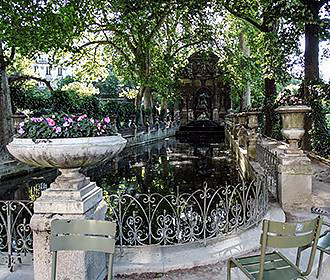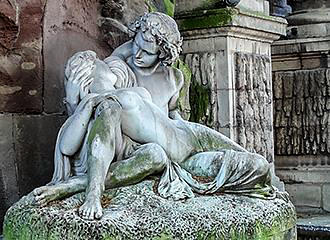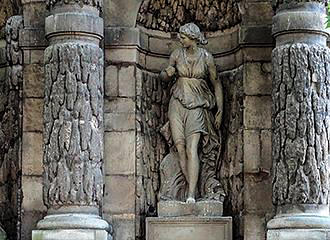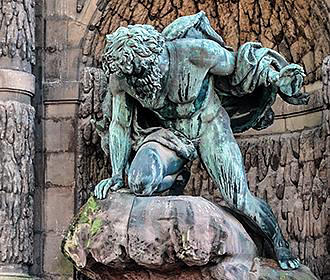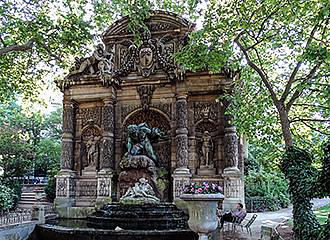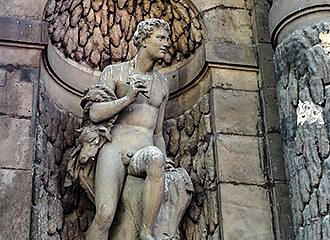Paris Medici Fountain in Jardin du Luxembourg
The Medici Fountain is a very historical fountain that was designed like a grotto reminiscent of one in the Boboli Gardens in Italy where Marie de Medici grew up, and she had this commissioned for the Jardin du Luxembourg when her palace was constructed, meaning it dates from the 1600s, even though it has been altered since with a different stretch of water with it and other statues.
Paris Medici Fontain Beginnings
It all starts with Marie de Medici who was the widow of King Henri IV and regent for King Louis XIII, who at the time was not happy living at The Louvre and wanted her own palace in Paris constructed in an Italian style that would remind her of where she grew up within the Palazzo Pitti in Florence Italy.
Queen Marie de Medici also wanted the gardens for her new palace in a very similar style to those of the Boboli gardens at the Pitti palace, and one of the things she requested was for a monumental water fountain.
Much of the gardens and this monumental water fountain in Paris were designed by Tommaso Francini, but water was a major issue, as there was a major lack of it on the left bank of the River Seine compared to the right bank where the Palais du Louvre was located.
Yet the problem was solved through the construction of an aqueduct, and the Paris Medici Fountain in Jardin du Luxembourg was created in around 1620 to look like a grotto or artificial cave, which was originally named the Grotte du Luxembourg, or the Cave of Luxembourg in English.
Adorned by columns the Paris Medici Fountain featured two allegorical statues on the top of the water fountain that were created by the sculptor Pierre Briard, and the walls were covered with reliefs, plus the basin of the Medici Fountain was originally circular, which remained like this for many, many years.
When French style gardens were more fashionable, the fountain eventually went into disrepair, just like much of the Jardin du Luxembourg Gardens, especially with the changes in ownership, the French Revolution, etc, that occurred during the rich history of the Jardin du Luxembourg.
Medici Fountain changes and how it is today
The original two statues on top of the Fontaine Medicis, which is known as the Medici Fountain in English, disappeared along with two nymphs that had pitchers where water poured from.
However, under the orders of Napoleon Bonaparte, in 1811 the Medici fountain was restored by the architect Jean Chalgrin who had designed the Arc de Triomphe, and he replaced the water fountain in the niche with two streams of water and added a white marble statue of Venus.
But by the 1840s the wall where the water fountain was located was crumbling, and eventually this along with the two lateral arcades of the Medici Fountain were torn down in 1855, yet with the plans for reconstructing the city of Paris under Baron Haussmann, one of the new roads he wanted meant that the water fountain was in the way.
Medici Fountain next stages to the present
Rather than destroying the Medici Fountain completely, it was decided that it should be moved, and from the years of approximately 1858 through to 1864 the architect Alphonse de Gisors moved the fountain about 30 metres within the Jardin du Luxembourg, and changed its appearance.
However, where it was moved to, meant there was no wall, and so there was actually no back to this ornate monumental water fountain, and it was Gabriel Davioud who decided to save another Paris water fountain from destruction, called the Fontaine de Leda, which had the same problem.
Therefore, the Fontaine de Leda was moved to the Jardin du Luxembourg Gardens and positioned behind the Medici Fountain, which is where it remains today.
Now some of the other changes made to the Medici Fountain included two new statues to replace the originals on the top, and these were designed as allegories representing the River Rhone, which was the work of artist Francisque Duret, and the River Seine, which was the work of the artist Claude Ramey.
In addition to these, two new statues were positioned into the niches on either side of the Medici Fountain, which were produced by the artist Auguste Ottin, and the one on the left as you look at the fountain depicts Faunus, the God of the forest, and the one on the right depicts Diana, the Goddess of the hunt.
There are also two masks above these statues and they represent comedy and tragedy, plus the coat of arms for the Medici family was also restored to how it would have been when the water fountain was first designed.
Also, instead of the original marble statue of Venus, an entirely new statue group was sculpted by Auguste Ottin, which is called Polyphemus Surprising Acis and Galatea, and this statue group depicts a mythical scene of the Polyphemus sculpted in bronze on a ledge looking down onto the lovers Acis and Galatea that were sculpted in white marble.
It was also at this time during the 1860s, when the Medici Fountain was being transformed, that a new rectangular basin was constructed, and this was lined by plane trees, which gives the area a lovely perspective and a truly romantic feel.
So this is how you will see the Medici Fountain today, which has also been classified as an historical monument in Paris.
Visiting the Paris Medici Fountain
Now as we have mentioned previously, this historical and monumental water fountain in Paris is situated within the Jardin du Luxembourg, which is in the 6th Arrondissement, and it is close to numerous other tourist attractions and monuments.
Located close to the Palais du Luxembourg on the North-East corner of the garden, when it comes to getting here via Paris public transport, you will find that the nearest Metro stations are the Vavin stop via line 4 or the Notre Dame des Champs stop via line 12.
However, it is actually closer to the RER train station called the Luxembourg stop serving the RER B Line, yet the bus numbers 21, 27, 38, 82, 84 and 89 along with the Noctilien Night Bus Service via Lines N14, N21 and N122 are also on the eastern side of the Jardin du Luxembourg Gardens.
Alternatively the Paris bus lines 58 and 83 will also get you within walking distance of Fontaine Medicis, plus there is a Velib station for the self service bike hire scheme located close by as well.
